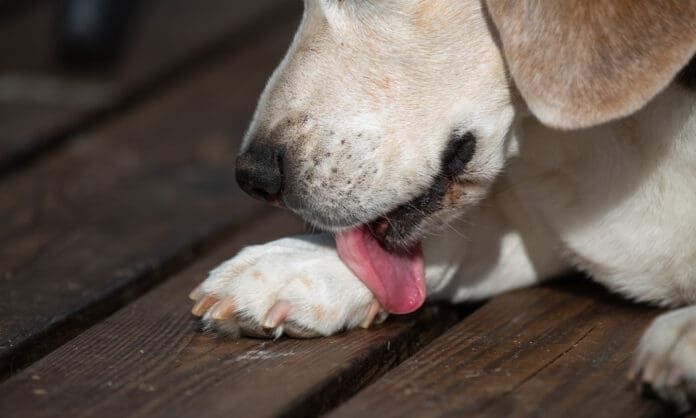Acral lick dermatitis is easy to spot. For one thing, you will notice your dog constantly licking his body over and over in the same spot. Over time, that area will become bald with raised skin that may ulcerate or bleed. The hair around the bald spot is often stained a dark reddish-brown from your dog’s saliva.
What Causes Acral Lick Granuloma in Dogs?
Acral lick dermatitis is a secondary problem that usually starts because of another health problem. The primary health condition causes pain, irritation, or itchiness, which causes the dog to lick, and over time the licking causes more irritation which makes the dog lick even more. Sometimes we’re not sure why the dog is licking, but we do know it can be difficult to break this cycle.
The first thing your veterinarian will do is try to figure out why your dog is fixating on a specific spot and licking that area so much. Underlying conditions that can lead to acral lick dermatitis include:
- Osteoarthritis
- Allergies to environmental allergens, food, or fleas
- Parasites such as fleas or mites
- Fungal infection
- Bacterial infection
- Obsessive compulsive disorder
- Anxiety
- Cancer
Sometimes it is obvious why your dog has developed acral lick dermatitis, other times it may take a couple rounds of testing to pinpoint the cause. For example, if your dog has severe osteoarthritis visible on X-ray right under the spot that he licks, the licking is probably an attempt to relieve pain. Behavioral causes and infections can take longer to determine.
Your dog may also have multiple things going on; for example, skin inflammation from allergies often leads to secondary bacterial infections.
Treating Acral Lick Dermatitis
The treatment for your dog’s acral lick granuloma will depend on his unique case. The three primary prongs of treatment are preventing further licking, treating any existing infection, and addressing the underlying cause.
Breaking the lick cycle is critical. Your dog may need to wear a cone or have a light bandage to prevent him from continuing to lick the area and make it worse. Bitter sprays may help too.
Medications that your dog may receive include antibiotics, pain medications, mite and flea treatments, or anti-anxiety drugs depending on your dog’s case. Veterinarians often use a combination of topical meds that you can apply directly to the sore and systemic medications that your dog takes by mouth. Acupuncture can be helpful.
In some cases, your veterinarian may recommend surgery to remove the damaged skin, close the wound, and give your dog a fresh start.
Patience Is Key
Treating acral lick dermatitis takes time and persistence. It can take weeks or months for the skin to heal and hair to grow back. Licking the same spot also can become a habit for the dog even after the initial cause is addressed. Be relentless about preventing your dog from continuing to lick.
With time, persistence, and some trial and error, you and your veterinarian will find the ideal treatment plan for your dog and break the itch-lick cycle.





